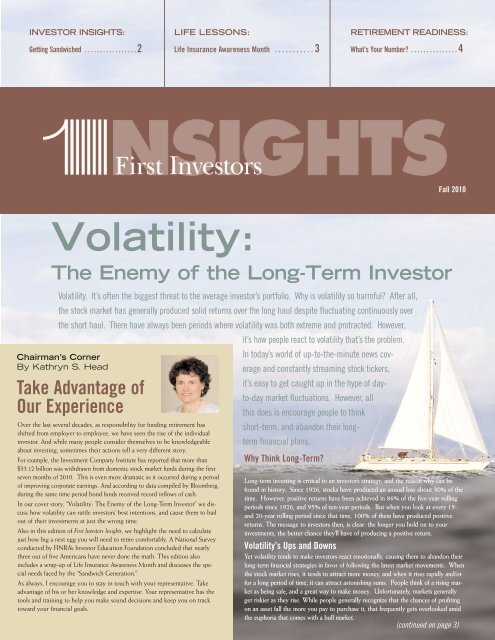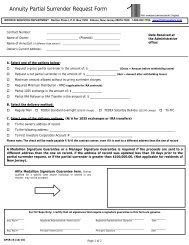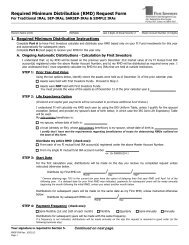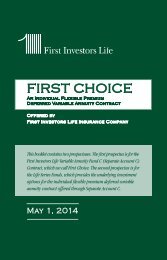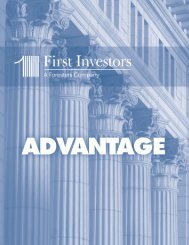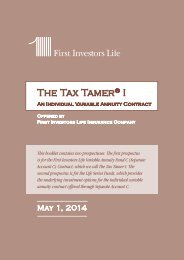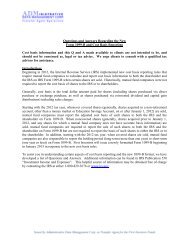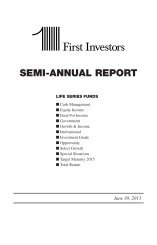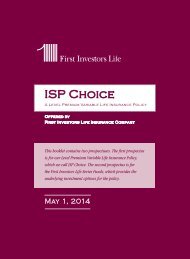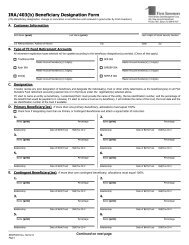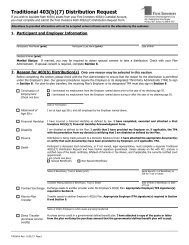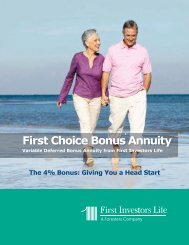Fall 2010 Issue - First Investors
Fall 2010 Issue - First Investors
Fall 2010 Issue - First Investors
You also want an ePaper? Increase the reach of your titles
YUMPU automatically turns print PDFs into web optimized ePapers that Google loves.
Getting SandwichedAccording to the Pew Research Center, 10 million boomers are raising their children,or supporting adult children, while at the same time lending a hand financially totheir parents. Chances are, you are or may soon be a part of this growing populationof dual caregivers—often called the “Sandwich Generation.” The SandwichGeneration faces a unique set of challenges.Privacy Policy of <strong>First</strong> <strong>Investors</strong>Corporation and Its AffiliatesYour privacy is important to us. We obtain personal informationabout you for the purposes of processing transactions in securities andinsurance products in accordance with your instructions, servicingyour accounts, and satisfying legal and regulatory requirements. Thepersonal information we typically obtain includes your name, address,occupation, age, social security number, financial resources, investmentobjectives, and accounts with other institutions. If you purchase lifeinsurance through us, we will also obtain information concerning yourmedical history, credit history and driving record. We collect informationabout you from a variety of sources, including forms and applicationsthat you provide to us, information that you provide to yourrepresentative, account records we receive as your dealer of record oragent, and information that is furnished to us by health care providers,clinics, other insurance companies, the Medical Information Bureau,and information and consumer credit reporting agencies.We maintain physical, electronic and procedural safeguards to protectyour information. We restrict access to your information to only thoseemployees who need to know that information to provide our productsor services to you and provide training to our employees regarding theproper handling of personal information. We share your personalinformation with our affiliated companies when it is necessary toprocess your transactions, service your accounts, or maintain yourrecords. We also share your information with third parties who needsuch information in order to process your transactions, service youraccounts, or maintain your records. We do not share any informationabout our current and former customers with anyone except as requiredor permitted by law or with your consent. Nor do we share your personalinformation with our affiliates or with unaffiliated third partiesfor their use in marketing their products or services.The Financial Industry Regulatory Authority (FINRA), has createdthe Public Disclosure Program to help investors select individualbrokers or securities firms by providing information regarding the disciplinaryhistory of FINRA member firms and their brokers. Torequest such information—or to receive a free brochure that includesinformation about the program —call 800-289-9999 or accessthe FINRA website at www.finra.org.At <strong>First</strong> <strong>Investors</strong>, we put the needs of our clients first. If you wouldlike to communicate with us directly about any matter, including acomplaint, you can call Shareholder Services at 800-423-4026or write to us at:<strong>First</strong> <strong>Investors</strong> CorporationRaritan Plaza 1PO Box 7837Edison, NJ 08818-7837Attn: Correspondence DepartmentMaterial contained in this publication should not be considered astax or legal advice. Articles are intended to be accurate, but <strong>First</strong><strong>Investors</strong> Corporation does not assume liability for loss or damage asa result of reliance on the views expressed herein. Address all correspondenceto: Editor, <strong>First</strong> <strong>Investors</strong> Insights, <strong>First</strong> <strong>Investors</strong>Corporation,110Wall Street, NewYork, NY10005-3830.Visit www.firstinvestors.com.2Caring for Aging ParentsTrying to juggle your aging parents’ needs withcaring for your children, running a household,and balancing a career is a challenge—especiallyfinancially. It’s no wonder many boomers arefeeling squeezed or “sandwiched” by all of theseresponsibilities.An important first step is to make sure your parentsare receiving all the assistance available to them.The U.S. Administration on Aging is a goodresource, as is the National Council on Aging. 1Both have websites that include information onelder care, caregiver resources, and servicesfor seniors.If your parents are still independent, don’t hesitateto talk to them about their financial status andfuture plans. Many people who feel prepared forlife post-retirement may have underestimated theirexpenses. The Employee Benefit Research Institute(EBRI) estimates that couples will need to saveabout $300,000 just to cover health-relatedexpenses, assuming they live to average lifeexpectancy and Medicare benefits remain atcurrent levels.But health care is just one cost factor senior citizensneed to consider. Though your parents maybe receiving income from Social Security or othersources—will it really be enough? Both you andyour parents could benefit from talking to yourrepresentative about what challenges may lieahead, and how to best prepare for them.Providing for ChildrenProviding for your children is no small expense.And with the prospect of their children going tocollege in the not-too-distant future, members ofthe Sandwich Generation may face even morefinancial challenges. If one of your goals is to savefor your children’s college education, talk to yourrepresentative about a tax-deferred vehicle such as a529 Plan or Education Savings Account, which canhelp build a college fund for your child while at thesame time provide valuable tax benefits to you.If your child is already in high school, you mayalso want to have a discussion with him or herabout what your family can and can’t afford whenit comes to college. Have your child take an activerole in planning for higher education—whetherthat means applying for scholarships, grants andloans, or working a part-time job to help defraycollege costs.Pay Yourself <strong>First</strong>With your myriad of responsibilities, don’t neglectthe most important person in your life: you. Whilemoney may be stretched, what with providing foryour parents and children simultaneously, you stillneed to “pay yourself first” by contributing to yoursavings and retirement accounts. It would be a mistaketo put off saving for your retirement, as thelonger you hold on to your accounts, the moretime they have to benefit from the power ofcompounding. If you have witnessed your parentsstruggling financially, you know just how importantit is to build up that nest egg. And unlike yourchildren, who will have the opportunity to applyfor grants and loans, you won’t have the option ofapplying for a retirement scholarship!Get Peace of MindWhen considering your finances, don’t forget theimportant component of life insurance. Now morethan ever it’s important to make sure you areadequately covered—you have two generationsdepending on you.Your representative is well equipped to deal with thefinancial challenges facing members of theSandwich Generation. Whether you’re looking tobuild your retirement nest egg, provide for yourparents, fund a child’s education, or all of theabove—your representative can help you formulatea strategy and recommend the investments that areright for you and your family.1 These entities are not affiliated with <strong>First</strong> <strong>Investors</strong> orits affiliates in any capacity. <strong>First</strong> <strong>Investors</strong> does notendorse or make any representations regarding theaccuracy of the information they provide.
Life InsuranceAwareness MonthSeptember <strong>2010</strong> marked the annual celebration of Life InsuranceAwareness Month (LIAM). LIAM is a national, nonprofit, industry-widemovement initiated by the LIFE Foundation 2 that reminds Americansof the importance of including life insurance in their financial plans.This year’s theme was “The Wonders of Life Insurance” and the LIFEFoundation came up with the following list of “The Seven Wonders ofLife Insurance”:Life insurance could help you and your family:Buy time… by allowing loved ones to focus on their grief by helping to payfor the funeral and other final expenses.Provide a fresh start… by letting families start with a clean slate by helpingto pay off credit card bills, outstanding loans and even the mortgage.Generate income… by helping to replace lost income for years to come sothat surviving family members can continue to pay for life’s necessities.Provide flexibility… by giving a surviving spouse the chance to take timeoff from work or to switch to a job that offers a more flexible work schedule.Create opportunities… by providing funding to start a business, or pay forschooling so surviving family members can train for a new career.Fund the future… byoffering a way to fundlonger-range goals likea college education forthe children or a secureretirement for the survivingspouse.Leave a legacy… bygiving parents thechance to leave futuregenerations with the legacy of long-term financial security.It’s never too late to celebrate the message of Life Insurance AwarenessMonth. If you currently don’t have life insurance, schedule an appointmentwith your representative right away. Even if you have coverage, it’s always agood idea to meet with your representative periodically to assess if yourpolicy still meets your needs.2 Adapted from www.wondersoflife.org. <strong>First</strong> <strong>Investors</strong> Corporation is not affiliated withthe LIFE Foundation and does not endorse or make any representations regarding theaccuracy of the information or life insurance tools they provide. <strong>First</strong> <strong>Investors</strong>Corporation is providing the information for general educational purposes and merely toserve as a basis for further discussion with your representative.Volatility: The Enemy of the Long-Term Investor (continued from cover)It works the other way too, and this is the scenario we saw so clearly over the last twoyears or so. As you know, economic and financial storm clouds began to form in late2007 and early 2008, and gave way to a full-blown meltdown by the fall. <strong>Investors</strong>fled the stock market in droves as the downturn intensified, with equity fund investorspulling out $250 billion between July 2008 and the end of March 2009. While thefear that led to these redemptions was understandable, the short-term nature of theinvestment decisions they represented was very damaging to investors. When stockprices have fallen a lot, people think that the market is dangerous, and amid the fearand gloom, may lose sight of the fact that lower purchase prices increase the chanceof selling at a profit. But by March of 2009, the stock market began a rebound thatgained 80% in 13 months. The investors who had pulled their money out of themarkets prematurely likely missed out on a majority of this rebound.Living With VolatilityThough many hoped the bear market of 2008 – 2009 was well behind us, volatility hascontinued into <strong>2010</strong>. If you turn on the television, you’ll find no shortage of punditsvoicing their bearish opinions on the road ahead for investors. However, there are someguidelines you can follow to help ensure that you stick with your long-term strategy.Seek balance—The best defense against market volatility is a diversified portfolio. Notall markets and market sectors move in lockstep, so holding a variety of securities makessense in tumultuous times. That way, a poor performing holding or group of holdingscan be offset by the positive performance of another. Meet with your representative tofind out if your portfolio is well diversified, and in line with your needs and goals.Turn off the news—If the daily financial chatter makes you anxious; don’t listen toit. Chances are, the goals you are saving and investing for are still years down theroad. Don’t be too preoccupied with what happens in the market today when thegoal you’re trying to reach is 10, 15 or 20 years in the future.Re-evaluate risk—However, if market fluctuations make you truly nervous, maybeit’s time to re-evaluate your tolerance for risk. Perhaps it’s worth it to you to exchangethe possibility of higher returns for more relative security. If so, speak with your representativeabout adding a less volatile investment, such as a government bond fund,to your portfolio.Go Green! …and Redand Blue!Our electronic (“e-delivery”) statements are now in color! Our new,full-color format makes it easier to see how your investments areallocated.Opting for e-delivery of your <strong>First</strong> <strong>Investors</strong> statements is the “green”choice, as it can save trees and money. Printing and mailing statements,as well as prospectuses, semi-annual and annual reports andtransaction confirmations are part of the Funds’ expenses. The moreclients who choose e-delivery of these documents, the lower the Funds’expenses will be—which ultimately benefits you, the shareholder. Signup for e-delivery today at www.firstinvestors.com or contactShareholder Services at (800) 423-4026 for more information.Seek dividends—Investing in securities that pay dividends can also be a hedgeagainst volatility. Dividends—distributions of a portion of a company’s earnings toshareholders—can help smooth out poor performance. Also, it’s generally the larger,more established companies that pay out dividends, and this stability can be astrength in volatile markets.Speak to your representative—While it’s not beneficial to fret over the day-to-dayfluctuations in the market, it is recommended that you check in with your representativeat least once annually to ensure that your portfolio is still in line with your needsand goals. Market fluctuations can skew your asset allocations; periodic meetingswith your representative can help ensure that you maintain your balance, and keepyou on the path to your financial goals.3
How Much Will You Need?What’s Your Number?There are certain numbers we don’t wish to share with others—our age,weight, or salary, for example. However, there’s one important number manykeep hidden even from themselves: how much they will need to retire.Many people have sustained losses in their portfolios in the bear market of 2008 –2009, and it looks like there may still be tough times ahead. It’s no wonder thatmany have decided to put thoughts of retirement out of their minds: it seems toodaunting to think about. But by not calculating what you’ll need now, you’re deprivingyourself of two key ingredients of retirement investing: knowledge and time.There are many factors that will affect how much you will need to retire comfortably, and each one is based on your individual goals andcircumstances. However, there is a quick-and-simple calculation that can serve as an estimate. Let’s look at a hypothetical example:Martin currently makes $75,000 a year. A general rule of thumb is that retirees will need about 80% of their current income to maintain asimilar standard of living in retirement. In Martin’s case, this means he would need:$75,000 x .80 = $60,000 a year in retirement Martin, who was born in 1950, used a Social Security Calculator to determine his monthly benefit if hewere to retire at age 65. His benefit came out to approximately $1,800 per month. That means Martin is responsible for saving enough on his own to have:$60,000 -12(1,800) =$38,400 a year in retirement Of course, no one can predict the future. But we can estimate (using Census Bureaudata) that Martin, at age 65, can expect to spend about 17 years in retirement.$38,400 x 17 = $652,800 Therefore, Martin needs to amass approximately $652,800 to fund his lifestyle in retirement.That sounds like abig number, and may overstate Martin’s needs because it assumes no earnings from his assets as he draws them down. If you assume thatMartin’s retirement assets earn 5% annually during his retirement, then Martin would need only $454,570.On the other hand, Martin might live much longer than 17 years. His assets might earn less than 5%. The rate of inflation might increase.With so much that is out of his control, Martin and anyone else wishing to retire comfortably should focus on what they can control, such ashow much they save and how long they work. In addition, anyone in this situation should seek the aid of a financial professional, and the soonerthe better. Those who begin their planning at younger ages are likely to have more options than those who wait. In any event, a financialprofessional like your representative can help you estimate how much you’ll need to retire, and help you chart a course to get there.How Can You Reach Your Number?After seeing the sizable sum the hypothetical Martin will need in retirement, it should be no wonder that real people are in fear of calculatingtheir own retirement numbers—especially when one considers that the average 401(k) plan balance is currently $45,519, according to theInvestment Company Institute’s <strong>2010</strong> Investment Company Factbook. That’s only about 7% of what Martin would need to comfortably retire.As stated earlier, the two key ingredients for successful retirement preparation are knowledge and time. The sooner Martin figures out his targetretirement number, the earlier he could begin working toward his goal, and the more time his money would have to benefit from the power ofcompounding. How powerful is compounding? Take a look:The long-term (1926 – 2009) average annual of return of the S&P 500 is 9.8%. To be conservative, let’s use a hypothetical average annual return of 8%.If Martin began putting away money at age40, he’d need to invest about 10% of hispaycheck ($7,500) at the beginning of eachyear to reach his goal:Age End of Year Balance40 . . . . . . . . . . . . . . . $8,10041 . . . . . . . . . . . . . . $16,84864 . . . . . . . . . . . . . $592,15865 . . . . . . . . . . . $647,630However, using the same rate of return, ifMartin had begun investing at age 35, hewould have only needed to invest $5,000 ayear, or less than $200 per paycheck,* toobtain even better results:Age End of Year Balance35 . . . . . . . . . . . . . . . $5,40036 . . . . . . . . . . . . . . $11,23264 . . . . . . . . . . . . . $611,72965 . . . . . . . . . . . $666,067Finally, had Martin begun investing at the outsetof his career, at age 25, he would have onlyneeded to put away $2,500 a year (or about$96 per paycheck*) to reach his retirementtarget—and still would have had enoughmoney left over to take a seniors’ cruise!Age End of Year Balance25 . . . . . . . . . . . . . . . $2,70026 . . . . . . . . . . . . . . . $5,61664 . . . . . . . . . . . . . $699,45265 . . . . . . . . . . . $758,108* assuming biweekly paycheckLearn Your Number; Devise a StrategyTake an example from Martin and calculate your retirement number today! Make an appointment to speak with your representative, who can help yougauge your target number with more accuracy. While your retirement goal may seem daunting at first, it will be easier to build toward it the earlier youbegin. Don’t let fear keep you from enjoying a comfortable retirement.


